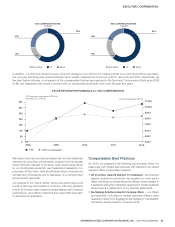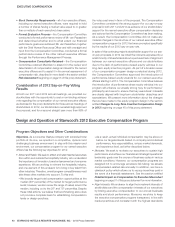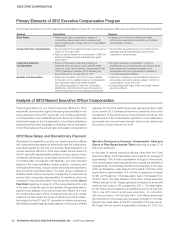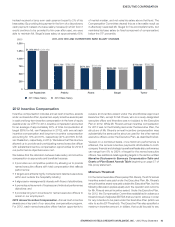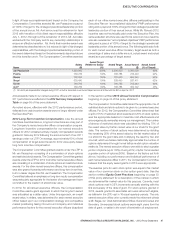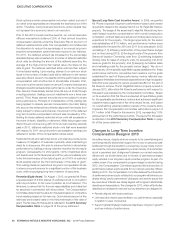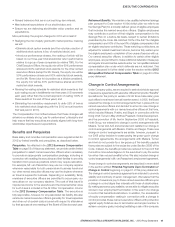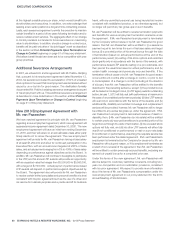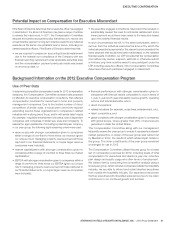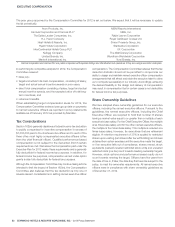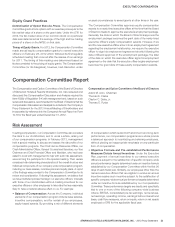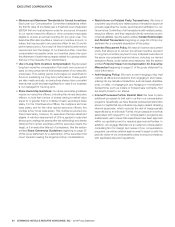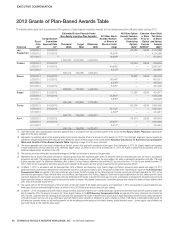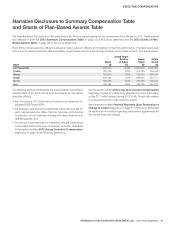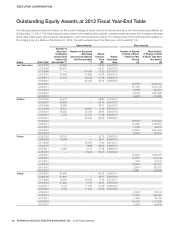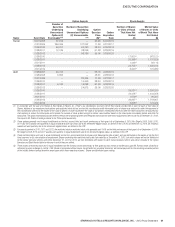Starwood 2012 Annual Report Download - page 55
Download and view the complete annual report
Please find page 55 of the 2012 Starwood annual report below. You can navigate through the pages in the report by either clicking on the pages listed below, or by using the keyword search tool below to find specific information within the annual report.STARWOOD HOTELS & RESORTS WORLDWIDE, INC.-2013Proxy Statement 49
EXECUTIVE COMPENSATION
•Reward behaviors that are in our best long-term interest;
•Meet external expectations of our stockholders; and
•
Ensure we are delivering stockholder value creation and on
expectations.
More particularly, the program changes for 2013 will consist of:
•
Realigning the mix of equity grants with market practice, meaning
we will:
–
Eliminate stock option awards (and the voluntary election of
additional stock options in lieu of restricted stock); and
–
Introduce performance shares, the vesting of which will be
based on our three-year total shareholder return performance
relative to a group of peer companies (or relative TSR). For the
Chief Executive Offi cer, the equity mix will be 60% performance
shares and 40% restricted stock awards; for the other named
executive offi cers (except for Mr. Rivera), the equity mix will be
50% performance shares and 50% restricted stock awards;
and for Mr. Rivera (due to his position as a division president),
the equity mix will be 40% performance shares and 60%
restricted stock awards;
•
Revising the vesting schedule for restricted stock awards so that
such vesting occurs in installments over three years (1/3 increments
each year) rather than the current approach of vesting 100% of
these awards at the end of three years; and
•
Eliminating the mandatory requirement to defer 25% of bonus
into restricted stock (beginning with the 2012 annual incentive
that was paid in 2013).
The Compensation Committee believes that these changes will
enhance our already strong “pay for performance” philosophy and
help ensure that key executives are closely aligned with long-term
stockholder objectives and expectations.
Benefi ts and Perquisites
Base salary and incentive compensation were supplemented for
2012 by limited benefi ts and perquisites, as described below.
Perquisites. As refl ected in the 2012 Summary Compensation
Table on page 55 of this proxy statement, we provide certain limited
perquisites to select named executive offi cers when necessary
to provide an appropriate compensation package, including in
connection with enabling the executives and their families to smoothly
transition from previous positions which may require relocation.
For example, Mr. van Paasschen may use our company airplane
whenever reasonable for both personal and business travel and
our other named executive offi cers may use the airplane whenever
air travel is required for business.Depending on availability, family
members of executive offi cers are permitted to accompany our
executives on our company airplane.The cost of that travel is
imputed as income to the executive and the incremental fair value
for such travel is included in the All Other Compensation column
in the 2012 Summary Compensation Table. The executive is
fully responsible, however, for any associated tax liability.We also
reimburse named executive offi cers generally for travel expenses
and other out-of-pocket costs incurred with respect to attendance
by their spouses at one meeting of the Board of Directors each year.
Retirement Benefi ts. We maintain a tax-qualifi ed retirement savings
plan pursuant to Code section401(k) (which plan we refer to as
the Savings Plan) for a broadly-defi ned group of eligible employees
that includes the named executive offi cers. Eligible employees
may contribute a portion of their eligible compensation to the
Savings Plan on a before-tax basis, subject to certain limitations
prescribed by the Code. We matched 100% of the fi rst 1% of eligible
compensation and 50% of the next 6% of eligible compensation that
an eligible employee contributes. These matching contributions, as
adjusted for related investment returns, become fully vested upon
the eligible employee’s completion of two years of service with us.
Our named executive offi cers, in addition to certain other eligible
employees, are permitted to make additional deferrals of base pay
and regular annual incentive awards under our nonqualifi ed deferred
compensation plan under which deferrals are not matched. This
plan is discussed in further detail under the section entitled 2012
Nonqualifi ed Deferred Compensation Table on page 60 of this
proxy statement .
Change in Control Arrangements
Under Company policy, we are required to seek stockholder approval
of severance agreements with executive offi cers that provide “Benefi ts”
(as defi ned in the policy) in excess of 2.99 times base salary plus
such offi cer’s most recent annual incentive award. In 2006, the Board
reviewed the change in control arrangements then in place with our
named executive offi cers and decided to enter into new change in
control agreements with our named executive offi cers at that time,
which included Messrs.Prabhu and Siegel. In connection with the
hiring of Mr.Turner in May2008 as President, Global Development,
and the promotion of Mr.Avril in September2008 to President,
Hotel Group, we entered into change in control arrangements with
Messrs. Turner and Avril and amended and restated our change in
control arrangements with Messrs. Prabhu and Siegel. These new
change in control arrangements are similar; however, pursuant to
our 2008 policy decision to cease paying tax gross-ups in change
in control agreements, the arrangements with Messrs.Turner
and Avril do not provide for a tax gross-up if the benefi ts payable
thereunder are subject to the excise tax under Section280G of the
Code. Instead, the benefi ts provided are reduced to the point that
it would be more advantageous to the executive to pay the excise
tax rather than reduce benefi ts further. We also included change in
control arrangements in Mr. van Paasschen’s employment agreement.
These change in control arrangements are described in more detail
in the section entitled Potential Payments Upon Termination or
Change in Control beginning on page 61 of this proxy statement .
The change in control severance agreements are intended to promote
stability and continuity of senior management. We believe that the
provision of severance pay to these named executive offi cers upon
a change in control aligns their interests with those of stockholders.
By making severance pay available, we are able to mitigate executive
concern over employment termination in the event of a change
in control that benefi ts stockholders. In addition, the acceleration
of equity compensation vesting in connection with a change in
control provides these named executive offi cers with protection
against equity forfeiture due to termination and ample incentive to
achieve company goals, including facilitating a sale of the company


